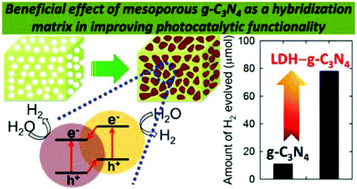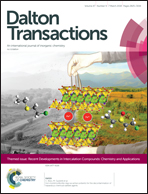Intercalative hybridization of layered double hydroxide nanocrystals with mesoporous g-C3N4 for enhancing visible light-induced H2 production efficiency†
Abstract
Efficient visible light active hybrid photocatalysts for H2 production can be synthesized by the intercalative hybridization of Zn–Cr-layered double hydroxide (Zn–Cr-LDH) with a mesoporous g-C3N4 lattice. Small Zn–Cr-LDH nanocrystals with a size of ∼6 nm are immobilized in the mesopores of g-C3N4. Beyond an optimal LDH/g-C3N4 molar ratio of 0.3, a further increase in the LDH content leads to the surface deposition of LDH crystals on the g-C3N4 material as well as the intercalative immobilization of LDH into its mesopores, indicating the controllability of the LDH deposition site. The Zn–Cr-LDH−g-C3N4 nanohybrids exhibit smaller surface areas than the pristine g-C3N4, confirming the intercalative stabilization of Zn–Cr-LDH nanocrystals in the mesopore of g-C3N4. The hybridization between Zn–Cr-LDH and g-C3N4 is effective in enhancing visible light absorptivity and also in depressing electron−hole recombination, which is attributable to an efficient electronic coupling between both the hybridized components. The present Zn–Cr-LDH−g-C3N4 nanohybrid exhibits promising photocatalytic activities for visible light-induced H2 production at a rate of 155.7 μmol g−1 h−1, which is much superior to that of the pristine g-C3N4 (21.7 μmol g−1 h−1). The present study underscores that the intercalative immobilization of Zn–Cr-LDH crystals in the limited space of a mesopore is quite useful in improving the visible light active photocatalyst functionality of mesoporous carbon nitride.

- This article is part of the themed collection: Recent Developments in Intercalation Compounds: Chemistry and Applications


 Please wait while we load your content...
Please wait while we load your content...